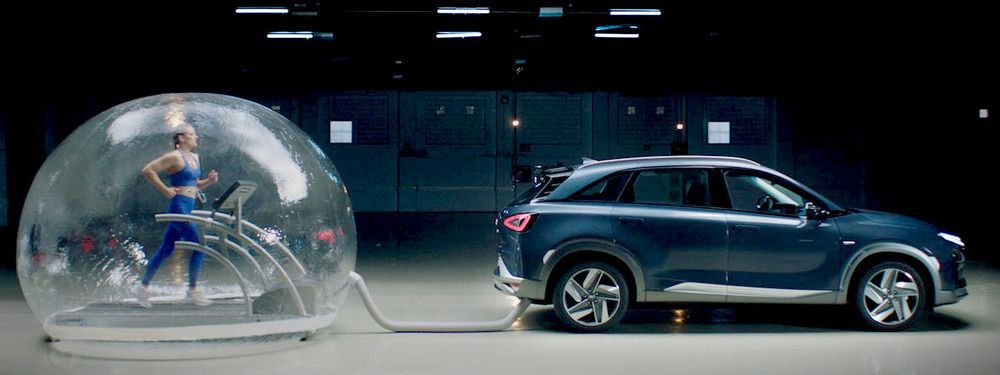Jan 21, 2021
Palantir’s God’s-Eye View of Afghanistan
Posted by Genevieve Klien in category: futurism
The company’s software can sift through enormous amounts of data, and those metrics can be used to make life-or-death decisions.
The company’s software can sift through enormous amounts of data, and those metrics can be used to make life-or-death decisions.


Hyundai Motor Spain has launched a campaign featuring brand ambassador and sportswoman Mireia Belmonte, which tests out Hyundai NEXO’s clean hydrogen fuel-cell technology.
Whereas cellular senescence is known to promote aging, many of the mechanisms controlling this process remain poorly understood. Using human mesenchymal precursor cells (hMPCs) carrying pathogenic mutations of the premature aging diseases Werner syndrome and Hutchinson-Gilford progeria syndrome, the authors conducted a genome-wide CRISPR-Cas9–based screen to identify genes that could affect cellular senescence. They identified KAT7, a histone acetyltransferase gene, as a driver of senescence. Inactivation of Kat7 in mice aging normally and in prematurely aging progeroid mice extended their life span. Although KAT7 requires further study in other cell types, these experiments highlight the utility of genome-wide CRISPR-Cas9 screens and shed further light on mechanisms controlling senescence.
Understanding the genetic and epigenetic bases of cellular senescence is instrumental in developing interventions to slow aging. We performed genome-wide CRISPR-Cas9–based screens using two types of human mesenchymal precursor cells (hMPCs) exhibiting accelerated senescence. The hMPCs were derived from human embryonic stem cells carrying the pathogenic mutations that cause the accelerated aging diseases Werner syndrome and Hutchinson-Gilford progeria syndrome. Genes whose deficiency alleviated cellular senescence were identified, including KAT7, a histone acetyltransferase, which ranked as a top hit in both progeroid hMPC models. Inactivation of KAT7 decreased histone H3 lysine 14 acetylation, repressed p15INK4b transcription, and alleviated hMPC senescence.
It may be theoretically impossible for humans to control a superintelligent AI, a new study finds. Worse still, the research also quashes any hope for detecting such an unstoppable AI when it’s on the verge of being created.
Slightly less grim is the timetable. By at least one estimate, many decades lie ahead before any such existential computational reckoning could be in the cards for humanity.
Alongside news of AI besting humans at games such as chess, Go and Jeopardy have come fears that superintelligent machines smarter than the best human minds might one day run amok. “The question about whether superintelligence could be controlled if created is quite old,” says study lead author Manuel Alfonseca, a computer scientist at the Autonomous University of Madrid. “It goes back at least to Asimov’s First Law of Robotics, in the 1940s.”
New research shows that patterns inspired by lobster shells can make 3D printed concrete stronger, to support more complex and creative architectural structures.
Digital manufacturing technologies like 3D concrete printing (3DCP) have immense potential to save time, effort and material in construction.
They also promise to push the boundaries of architectural innovation, yet technical challenges remain in making 3D printed concrete strong enough for use in more free-form structures.
Scientists at the University of Southampton and University of Edinburgh have developed a flexible underwater robot that can propel itself through water in the same style as nature’s most efficient swimmer—the Aurelia aurita jellyfish.
The findings, published in Science Robotics, demonstrate that the new underwater robot can swim as quickly and efficiently as the squid and jellyfish which inspired its design, potentially unlocking new possibilities for underwater exploration with its lightweight design and soft exterior.
Co-author Dr. Francesco Giorgio-Serchi, Lecturer and Chancellor’s Fellow, at the School of Engineering, University of Edinburgh, said: “The fascination for organisms such as squid, jellyfish and octopuses has been growing enormously because they are quite unique in that their lack of supportive skeletal structure does not prevent them from outstanding feats of swimming.”
Traffic lights at intersections are managed by simple computers that assign the right of way to the nonconflicting direction. However, studies looking at travel times in urban areas have shown that delays caused by intersections make up 12–55% of daily commute travel, which could be reduced if the operation of these controllers can be made more efficient to avoid unnecessary wait times.
Humans are able to find objects in their surroundings and detect some of their properties simply by touching them. While this skill is particularly valuable for blind individuals, it can also help people with no visual impairments to complete simple tasks, such as locating and grabbing an object inside a bag or pocket.
Researchers at Massachusetts Institute of Technology (MIT) have recently carried out a study aimed at replicating this human capability in robots, allowing them to understand where objects are located simply by touching them. Their paper, pre-published on arXiv, highlights the advantages of developing robots that can interact with their surrounding environment through touch rather than merely through vision and audio processing.
“The goal of our work was to demonstrate that with high-resolution tactile sensing it is possible to accurately localize known objects even from the first contact,” Maria Bauza, one of the researchers who carried out the study, told TechXplore. “Our approach makes an important leap compared to previous works on tactile localization, as we do not rely on any other external sensing modality (like vision) or previously collected tactile data related to the manipulated objects. Instead, our technique, which was trained directly in simulation, can localize known objects from the first touch which is paramount in real robotic applications where real data collection is expensive or simply unfeasible.”
New photo-ferroelectric materials allow storage of information in a non-volatile way using light stimulus. The idea is to create energy efficient memory devices with high performance and versatility to face current challenges. The study has been published in Nature Communications by Josep Fontcuberta and co-workers and opens a path towards further investigations on this phenomenon and to neuromorphic computing applications.
Can you imagine controlling the properties of a material by just shining light on it? We are used to seeing that the temperature of materials increases when exposed to the sun. But light may also have subtler effects. Indeed, light photons can create pairs of free charge carriers in otherwise insulating materials. This is the basic principle of the photovoltaic panels we use to harvest electrical energy from sun.
In a new twist, a light-induced change of materials’ properties could be used in memory devices, allowing more efficient storage of information and faster access and computing. This, in fact, is one of our society’s current challenges: being able to develop high-performance commercially available electronic devices which are, at the same time, energy efficient. Smaller electronic devices having lower energy consumption and high performance and versatility are the goal.
